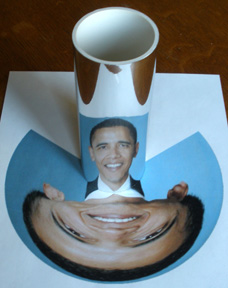
Introduction to Anamorphic Art
The word anamorphic is from the Greek ana (again) and morphe (form). It refers to images that are so heavily distorted that they are hard to recognize without the use of a curved mirror, sometimes referred to as an anamorphoscope. When viewed in the anamorphoscope, the image is "formed again", so that it becomes recognizable.
European painters of the early Renaissance were fascinated by linear anamorphic images, in which stretched pictures are formed again when viewed on a slant. Reportedly,
Leonardo da Vinci's notebooks contain the first known examples of anamorphic art. A famous example of a painting utilizing anamorphic art is Hans Holbein's The Ambassadors (1533), which contains a stretched-out skull. The painting could be hung at the top of a stairway such that people ascending the stairs would be startled by the skull image. Linear anamorphoses have also been employed in puzzles, children's books, etc. An example is an old newspaper puzzle by Sam Lloyd which contains a hidden linear anamorphosis of George Washington.

Anamorphic paintings which require cylindrical mirrors were popular in both Europe and the Orient in the 17th and 18th centuries. These sometimes carried messages of political protest or erotic imagery. The Spanish surrealist
Salvador Dali produced a set of erotic anamorphic paintings as well. To create these, he simply looked into the anamorphoscope while painting. It is also possible to construct grids to guide the creation of the distorted image.
Click here to browse products related to anamorphic art.
Math + Art topics
mathartfun.com home
© 2000-2015 Tessellations


